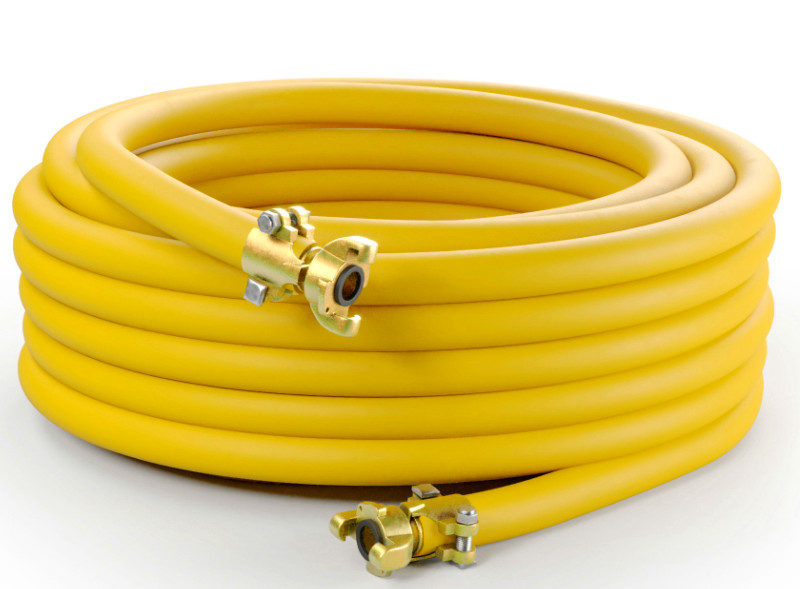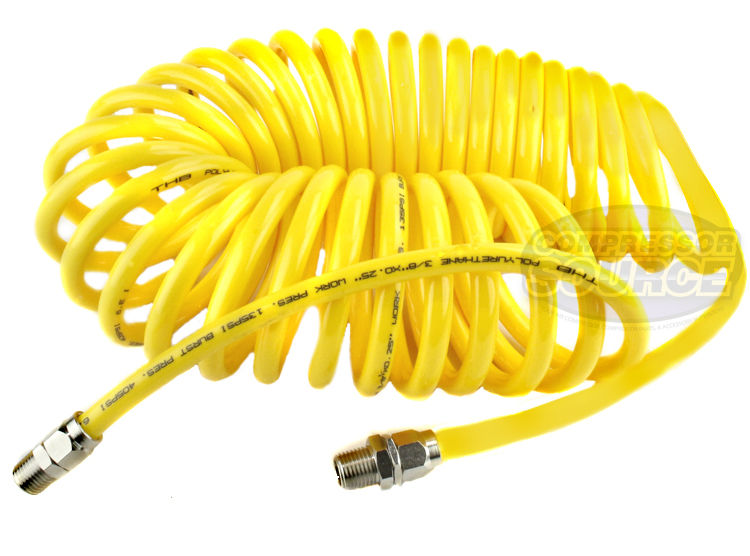If you use an air compressor, you know how important the right hose is. Your air compressor hose is the lifeline that connects your tool to power.
But not all hoses are created equal. Choosing the wrong one can lead to leaks, low pressure, or even damage to your equipment. You’ll discover what makes a great air compressor hose, how to pick the perfect one for your needs, and tips to keep it working like new.
Keep reading to make sure your tools perform at their best every time.
Types Of Air Compressor Hoses
Air compressor hoses come in various types. Each type suits different tasks and environments. Choosing the right hose can improve work efficiency and safety.
Some hoses are light and flexible. Others are strong and durable. Knowing the main types helps you pick the best hose for your needs.
Pvc Hoses
PVC hoses are lightweight and affordable. They resist chemicals and abrasion well. These hoses work best for light-duty tasks indoors. They do not handle extreme heat or heavy pressure.
Rubber Hoses
Rubber hoses are flexible and strong. They can handle high pressure and tough conditions. These hoses resist kinks and wear easily. Ideal for outdoor and heavy-duty use.
Hybrid Hoses
Hybrid hoses mix materials like rubber and PVC. They balance flexibility, strength, and weight. These hoses perform well in many settings. A good choice for general use and durability.
Polyurethane Hoses
Polyurethane hoses are very light and flexible. They resist cuts, abrasion, and weather well. These hoses keep shape and resist kinks. Perfect for tight spaces and tool connections.
Key Features To Consider
Choosing the right air compressor hose is important for good performance. Many features affect how well the hose works. These features help you pick a hose that fits your needs. Understand these key points before buying.
Length And Diameter
The hose length determines how far you can reach. Longer hoses give more freedom but may reduce air pressure. Diameter affects air flow. Bigger diameter means more air passes through. Choose length and diameter based on your tool and workspace.
Pressure Ratings
Pressure rating shows how much air pressure the hose can handle. Use a hose with a rating higher than your compressor’s output. This prevents damage and keeps you safe. Check both working pressure and burst pressure values.
Flexibility And Weight
Flexible hoses are easier to move and store. Light hoses reduce fatigue during work. Heavy or stiff hoses can be hard to handle. Look for a balance between flexibility and strength for comfort.
Durability And Resistance
Durability means the hose lasts long under tough conditions. Good hoses resist kinks, cuts, and abrasions. Resistance to chemicals and weather is also important. Pick hoses made of strong materials for longer life.
Choosing The Right Hose For Your Compressor
Choosing the right hose for your air compressor is important. The hose connects your compressor to tools and machines. It affects the air flow and overall performance. Picking the correct hose size and type helps avoid pressure loss and damage. This guide covers key points to consider for the best fit.
Matching Hose Size To Compressor Output
Hose size must match the compressor’s output capacity. A small hose limits air flow and lowers pressure. A large hose may be heavy and hard to handle. Check the compressor’s CFM (cubic feet per minute) rating. Choose a hose diameter that supports this flow rate. This ensures steady air supply without pressure drops.
Compatibility With Tools
Not all hoses work with every tool. Look at the tool’s air inlet size and pressure needs. The hose fittings must match the tool’s connectors. Using wrong fittings causes air leaks and tool damage. Choose hoses rated for your tool’s maximum pressure. This keeps your tools working safely and well.
Environmental Factors
Consider the work environment where you use the hose. Outdoor jobs may need hoses that resist sunlight and water. Hot or cold conditions require hoses that stay flexible. Rough surfaces or chemicals need durable and abrasion-resistant hoses. Picking the right hose material ensures long life and safe use in all conditions.
Common Hose Fittings And Connectors
Air compressor hoses need the right fittings and connectors to work well. These parts link hoses to tools, compressors, and other equipment. Choosing the right fittings keeps air pressure steady and stops leaks. Understanding common hose fittings helps you pick the best parts for your needs.
Thread Types
Thread types connect hoses securely. The most common threads are NPT and BSP. NPT threads taper and seal tightly with pressure. BSP threads are common outside the US. Using the correct thread prevents air leaks and damage. Always match the thread type to your hose and tool.
Quick Connect Couplers
Quick connect couplers save time. They let you attach and detach hoses fast. These couplers lock in place to hold air pressure. Different sizes fit various hose diameters. Couplers come in male and female parts. They make switching tools easy during work.
Adapters And Accessories
Adapters change one fitting type to another. They help connect hoses with different threads or sizes. Accessories include plugs and caps to stop air flow. Hose reels and clamps keep hoses neat and safe. Using the right accessories improves hose life and safety.
Maintenance Tips For Air Compressor Hoses
Proper maintenance of air compressor hoses extends their life and improves safety. Regular care prevents leaks and keeps air flowing smoothly. Follow these simple tips to keep hoses in top shape.
Storage Practices
Store hoses in a cool, dry place away from direct sunlight. Avoid sharp bends or kinks that damage the hose walls. Coil hoses loosely on a rack or hang them to keep their shape. Keep hoses off the ground to prevent dirt and moisture buildup.
Leak Detection
Check hoses often for small holes or cracks. Spray soapy water on the hose and watch for bubbles. Listen for hissing sounds that signal escaping air. Fix leaks quickly to maintain pressure and reduce energy waste.
Cleaning And Inspection
Clean hoses regularly with a damp cloth to remove dirt and dust. Inspect fittings for tightness and rust. Look inside the hose for blockages or wear. Replace hoses that show cracks, hard spots, or leaks to ensure safe use.

Credit: www.somaxflex.com
Troubleshooting Hose Issues
Air compressor hoses are vital for smooth air flow. Problems with hoses reduce performance and cause delays. Troubleshooting hose issues helps maintain your tool’s efficiency and safety.
Regular checks prevent small problems from becoming big. Identify issues early to save time and money. Focus on common hose problems like kinks, leaks, and wear.
Kinks And Twists
Kinks and twists block air flow and strain the hose. They cause uneven pressure and reduce tool power. Straighten the hose gently to remove kinks. Avoid sharp bends by storing hoses properly. Use hose reels or hangers to keep hoses untangled.
Air Leaks
Air leaks waste energy and reduce compressor output. Listen for hissing sounds along the hose length. Use soapy water to spot bubbles from leaks. Tighten fittings and replace damaged connectors. Small leaks can grow larger if ignored.
Wear And Tear Signs
Wear and tear weaken hoses and cause bursts. Check for cracks, splits, or worn spots on the hose surface. Look for discoloration or stiffness that signals aging. Replace hoses showing these signs to avoid failure. Regular inspection extends hose life and ensures safety.
Top Brands And Products
Choosing the right air compressor hose is key for effective work. Top brands offer products that last long and perform well. Quality hoses resist wear, heat, and pressure. This section highlights trusted brands and products in the market.
Budget-friendly Options
Affordable hoses suit casual users and small projects. Brands like Flexzilla and Campbell Hausfeld offer good value. These hoses are lightweight and flexible, making them easy to handle. They work well for home tasks and light industrial use. Durable materials ensure decent lifespan without high cost.
Premium Choices
Premium hoses deliver top performance and durability. Brands such as Goodyear and Milton excel in quality. These hoses resist kinks and extreme temperatures. They suit professional workshops and heavy-duty jobs. Premium hoses provide consistent airflow and longer service life.
Specialized Hoses
Specialized hoses fit unique needs and environments. Some brands focus on chemical resistance or extreme cold. For example, Parker offers hoses for harsh industrial conditions. Others provide extra-long or lightweight designs for specific tools. Choosing specialized hoses improves safety and efficiency.

Credit: compressor-source.com

Credit: www.amazon.com
Frequently Asked Questions
What Is An Air Compressor Hose Used For?
An air compressor hose delivers compressed air from the compressor to tools. It ensures efficient airflow and tool operation. Different hoses suit various pressure levels and applications. Choosing the right hose improves performance and safety. Proper maintenance extends its lifespan and prevents leaks.
How To Choose The Right Air Compressor Hose?
Select a hose based on length, diameter, and material. Consider the maximum pressure rating of your compressor. Flexible, durable hoses like rubber or PVC are common choices. Match the hose size to your tools for optimal airflow. Always check compatibility with your air compressor model.
How To Maintain An Air Compressor Hose Properly?
Keep the hose clean and dry to prevent damage. Regularly inspect for cracks, leaks, or wear. Store it coiled without sharp bends or kinks. Avoid exposing the hose to extreme temperatures or chemicals. Timely replacement prevents air loss and ensures safety.
Can I Use Any Hose For My Air Compressor?
No, not all hoses are suitable for air compressors. Use hoses rated for the compressor’s pressure and airflow. Incompatible hoses risk bursting or poor tool performance. Always check manufacturer recommendations before using a hose. Using the correct hose ensures safety and efficiency.
Conclusion
Choosing the right air compressor hose matters a lot. It keeps your tools working well and safe. A good hose fits your needs and lasts long. Check its size, material, and pressure rating. Don’t forget to store it properly to avoid damage.
Simple care helps you save money and time. Use the right hose and work with ease every day.

